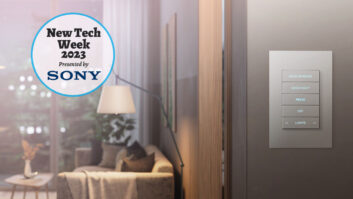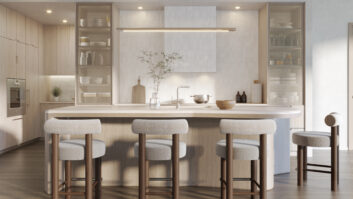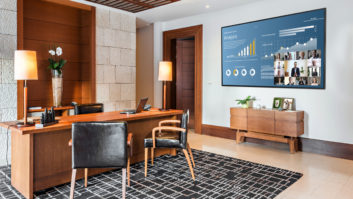Utah Builder and ESC Make Integrated Home System the Latest Template Amenity


The technology package offered inside the Daybreak model homes includes an IP-based security system, lighting with C4-DIM1-Z wireless dimmers, a CCZ-T1-W Wireless thermostat, Kwikset ZigBee deadbolt door locks with SmartCode keyless entry, and a two-zone distributed music system with a Control4 iPod docking station. Above, l-r, Craig Stucie from Safe & Sound, Todd Hamel from Holmes Homes, and Glen Mella from Control4.
The next chapter in home automation may have taken place this past year, and as if to underscore the nature of that future, it began with a product that didn’t even exist a year earlier and will require residential systems integrators to “sharpen their pencils” to be part of it.
Holmes Homes, a production builder in Salt Lake City, has partnered with control systems manufacturer Control4 and Draper, Utah, integrator Safe & Sound Systems, to put together a surprisingly sophisticated automation package.
The package includes security, distributed audio (including a 30-day subscription to Rhapsody), controlled lighting and HVAC control, all running on an Apple iPad that buyers get at the contract signing, in seven new home models in the Daybreak development in a Salt Lake City suburb. It’s the largest residential project in the state, accounting for nearly 20 percent of all new homes sold in Utah.
What’s remarkable is that these automation technology packages will be standard in all new Holmes’ homes, included in prices that start at $130,000 for a 680-square-foot one-bedroom/ one-bath loft-type condominium unit. Putting an automation system that comprehensive into such affordable new construction could represent a tipping point in home automation’s penetration of the market.
Offering Real Benefits to Home Buyers
Sherrie Hallevertt, director of marketing for Holmes Homes, says that rather than waiting for the market to produce more affordable home automation products, she sees the offering of just enough automation features to entice buyers combined with the implementation of them by production builders who can drive economies of scale as the way forward.
“If you can offer real benefits, like letting people have their music all over the house and using wireless deadbolt locks to know when their kids come home from school, then you’ll see home automation become as standardized as air conditioning in new homes,” Hallevertt said.

Holmes Homes (one of 13 different builders at Daybreak) has nearly a third of all the 20 model homes there where most other builders have one.
But if this is the opening salvo in what could become the commoditization of home automation technology, it also illustrates how integrators will have to approach the market.
“We had to sharpen our pencils,” is the trope that Daron Bush, director of sales for Safe & Sound Systems, used to express the number crunching and cost negotiations the company had to do make the project work. Safe & Sound, whose residential integration business is typically split between production and custom builders, had been aware of Holmes Homes for some time as it watched the builder continue to gain market share in the area. For instance, in Daybreak, the builder has about one third of the approximately 2,400 houses in the sprawling development. And in a somewhat atypical arrangement, Holmes Homes (one of 13 different builders at Daybreak) has nearly a third of all the 20 model homes there where most other builders have one.


More Tech Savvy Than Most
Bush noted that Holmes was already more tech savvy than most builders; it was already planning to begin using the iPad as a sales tool, giving one to new buyers and using it as the medium through which every bit of information was passed between builder and buyer, from choosing upgrades to the final inspection and sales documentation. The integrator approached the builder at a serendipitous moment, as well. Holmes was about to drop its current integration subcontractor, and Bush and his team made the suggestion that Holmes extend the iPad technology concept to home automation. They found a receptive audience.
Together, the builder and integrator approached locally based Control4 to source systems and products. From an initial package that included basic security and lighting, Holmes and Safe & Sound quickly expanded.
“We went from a single door with a controlled bolt to putting them on all doors,” Bush recalled.
Lighting was similarly expanded inside and outside of the home, with macros for scenes such as arrival and sleep programmed into Control4’s ZigBee-based HC- 300C whole-home controller. As the package developed, so did the marketing plan. The expanded lighting system, for instance, would be expressed by the catchphrase, “You’ll never come home to a dark house again,” on Holmes’ brochures that touted the technology package.
The Tech Package
The technology package, which Control4 valued at between $10,000 and $12,000 including installation, is now substantial. It includes an IPbased security system, lighting with C4-DIM1-Z wireless dimmers, a CCZ-T1-W Wireless thermostat, Kwikset ZigBee deadbolt door locks with SmartCode keyless entry, and a two-zone distributed music system with a Control4 iPod docking station, as well as the Apple iPad, which, now loaded with the Control4 My Home iPad App, would function as a wireless controller for the systems.
But to keep the home price down in a stillbattered housing market, and to do so without reducing other amenities, those sharpened pencils had to be put to work. “We had to go to all our suppliers and vendors and discuss costs,” Bush explained. “Some were willing to reduce prices, some weren’t. If they didn’t, we went elsewhere.”
However, Safe & Sound had more takers than not. There was excitement building around the technology package that actually offered them some leverage on pricing with the expectation that this could be the start of an ongoing proposition.
“Holmes was planning on 150 homes, but it could go to 200,” Bush said. “This was something no one else is doing. Anyone can have granite countertops, but no one else has this level of a technology package. It’s a huge market differentiator.”

Sherrie Hallevertt, director of marketing for Holmes Homes, noted that if you can offer real benefits, like letting people have their music all over the house and using wireless deadbolt locks to know when their kids come home from school, then you’ll see home automation become as standardized as air conditioning in new homes.
The Challenges of Production Building
Production homebuilding has its own frenetic schedule and Daybreak was no different. The model homes had to be built inside a window of 60 days, foundation to finish. Safe & Sound found its own economies, as well. For instance, all programming of the Control4 main system was done at the shop and was applied as a data dump to all of the homes. Also, because a single builder was the customer, rather than seven individual homeowners, the amount of time spent on bidding and job costing, and on system design was greatly reduced.
“That was a huge savings,” said Bush, who noted that time and cost were also saved by having components such as the iPod dock and Control4 C4-TSWMC7-EG InfinityEdge touchscreen controller placed in the same location in every home. A standardized package of products would also offer inventory advantages going forward, as well. (Holmes Homes intentionally offers very few upgrades prior to the sale of the home, such as a basic home theater, to leverage that advantage.) Home automation was experiencing the same kind of “templatization” that other amenities enjoy, and gaining the same cost benefits.

Lighting was similarly expanded inside and outside of the home, with macros for scenes such as arrival and sleep programmed into Control4’s ZigBee-based HC-300C whole-home controller.
The schedule was hectic, but Safe & Sounds’ nine technicians and two project supervisors finished all seven homes in time for the grand opening last summer. “Sometimes it took us a week to chase down some items, and we often had to wear two or more hats at a time, but we did it,” Bush said.
Is Daybreak a Template for the Future?
Safe & Sound Systems’ Daron Bush says the Daybreak project is already paying dividends, with his integration firm receiving calls from at least three other builders asking them to create similar production-level technology packages. However, he says, the answer is no, at least for now. “It’s a partnership,” he says. “We feel like we developed this package specifically for Holmes Homes and we want to keep it exclusive.”
Jim Arnold, Control4 vice president of sales, says the company does not have and isn’t considering a direct-to-builder distribution channel. But, he says, the company is ramping up awareness of the Daybreak project among its 14,000 dealers in North America, encouraging them to evangelize the concept to production builders in their territories. He says that besides opening up a potentially vast new market in entry-level homes, it offers integrators the opportunity to service and upsell those homebuyers after the closing.
The concept is right in the pocket for value-based Control4, which has pursued high-profile sales including a luxury condo in Manhattan and the new Aria hotel in Las Vegas. But this is the first time its products have been used in this scale in entry-level production homes. “This is really a gamechanger for everyone–for us, for integrators and for production builders,” Arnold said.
–Dan Daley
Dan Daley is a freelance writer in Nashville, Tennessee.







